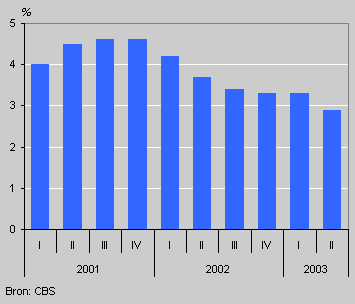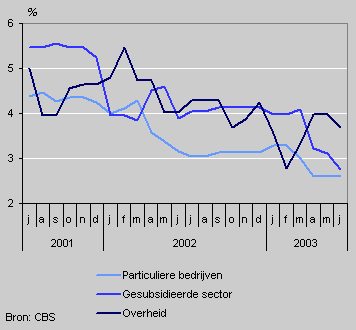Collective wages no longer growing as fast

In the second quarter of 2003 the collective wages increased by 2.9 percent on the year before. In the first quarter, the collective wage increase was still 3.4 percent. Collective wages started to fall in 2002. In 2001 the wage increase was 4.4 percent, the highest since 1982.
Collective wage increase higher than the negotiated 2.5 percent
In 2002 the employers and employees federations agreed to limit the wage increase in 2003 to a maximum of 2.5 percent. In the first half the cao wages increased by 3.1 percent however.
Collective wage increase per quarter

Great government wage increase
Government wage increases were higher than in the private sector. In the second quarter of 2003 public sector wages increased by 3.9 percent on the previous year. This was 2.6 percent in the private sector. Much of the difference is due to special payments. In the public sector contractual end of the year payments and one off bonuses increased by 0.6 percent. On balance these fell slightly in the private sector.
Situation similar in 2001 and 2002
In 2001 and 2002 wage increase in the private sector were also lower than in the public and subsidised sector, where almost a quarter of the wage increase consisted of special payments. The differences between the sectors are much smaller when these special payments are not taken into consideration.
Collective wages by sector

Three quarters of all collective wage agreements ready
It is not unusual that the previous cao period is already over before any final agreement for a new cao is reached. In such cases the wage increases in the new cao are agreed on in retrospect. The figures on June are based on three quarters of the cao. Final wage agreements until the end of the year are concluded for over half of the collective agreements.
Han van den Berg